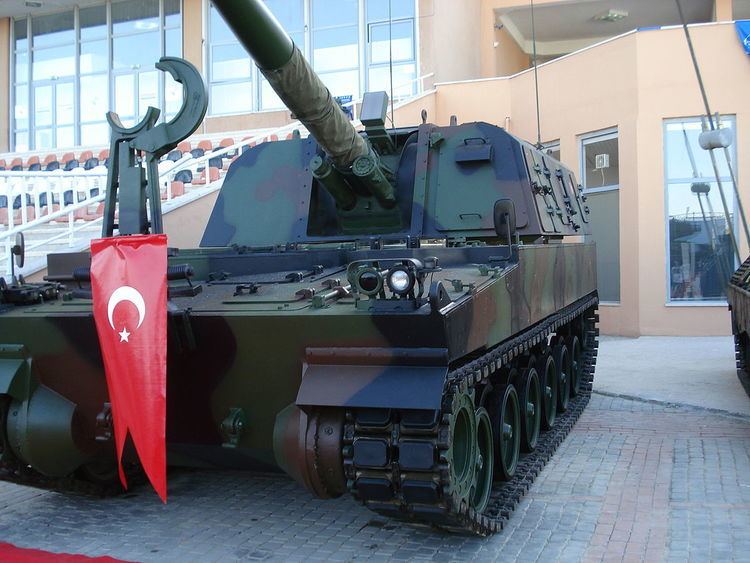Produced 2001–Present | Designed 1998–2001 Weight Combat: 56 tons | |
 | ||
Wars Turkey-PKK conflictTurkey-PYD conflictTurkey-ISIS conflict | ||
T-155 Fırtına (Storm) is a Turkish 155mm self-propelled howitzer based on the K9 Thunder by Samsung Techwin.
Contents
- Ammunition Resupply Vehicle
- Turkey
- Azerbaijan
- Current operators
- Operational history
- Related development
- Similar vehicles
- References
Though essentially using the subsystems of the K9 howitzer, including the South Korean designed 155/52 caliber gun system and automatic ammunition feeding mechanism, and the German designed MTU-881 KA 500 diesel engine, the T-155 has considerable differences in its turret design, parts of the chassis, the navigation system, and electronic systems (such as the radio and fire control system) which were developed in Turkey. Unlike the K9, T-155 Fırtına lacks commander's digital panoramic sight. Through the Inertial Navigation System produced by ASELSAN the howitzer is able to determine the coordinates of the targets at 17.5 meters deviation. Fırtına can open fire within 30 seconds.
According to the licence agreement with Samsung Techwin, the first eight T-155s were built in South Korea, while the remaining batch of more than 300 units would be produced in Turkey. The total reported cost of purchase and technology transfer for the Turkish government was $1 billion.
The T-155 Fırtına has a maximum firing range of 40 km, depending on the type of ammunition. It can reach a top speed of 66 km/h and has an operational range of 480 km.
The T-155 howitzers are built at the 1st Army Maintenance Center Command of the Turkish Army in Adapazarı. Cannon is produced in Kirikkale facility of MKEK. The production rate of the T-155 is 24 units per year. From 2001 to December 2009, more than 150 units have been delivered to the Turkish Army. A total of 350 T-155 Fırtına howitzers are planned to be produced.
Ammunition Resupply Vehicle
Recent developments have been made within Turkey to develop an indigenous Ammunition Resupply Vehicle based on T-155 Fırtına, the vehicles will have an Ammunition Transfer System similar to that of the South Korean K10 ARV. This vehicle will have a boom that is extended towards the rear of the T-155 Fırtına turret where the exchange will take place. The Turkish ARV will have an Auxiliary Power Unit unlike the K10 ARV, which allows the vehicle's crew to use electronics, communication systems and an Ammunition Transfer System to run economically without the main engines being turned on.
Turkey
The Turkish Armed Forces has placed an order to manufacture 350 vehicles in total with 24 vehicles rolling off of the assembly line every year.
Azerbaijan
Talks were held with the Azerbaijani government regarding the purchase and sale of the military equipment. The sides were expected to sign the contract by the end of 2011. A contract for 36 T-155 howitzers was signed in 2011, but was delayed due to complications regarding the German production of the engines and an embargo on Azerbaijan connected to conflict with neighboring Armenia. It was later reported that deliveries would start in 2014.
Current operators
Operational history
The T-155 Fırtına was first deployed in Operation Sun at the end of 2007 into January 2008 to fight the PKK militants in the northern part of Iraq.
The T-155 was used in 2012 Syrian–Turkish border clashes and again in Jarabulus offensive (2016).
